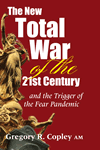Featured Release
Non Fiction
The New Total War of the 21st Century and the Trigger of the Fear Pandemic, by Gregory R. Copley, AM (Melbourne, 2020: Sid Harta Publishers) is a work of philosophy and analysis on the transformed nature of human society and the way it goes about the business of survival in the 21st Century.
Copley, an Australian, but working with governments around the world, notes in this, his 36th book, that "war is complex, and became exponentially more complex as the 21st Century grew". He says that a simmering conflict became a "total war" of a new type, erupting in 2020, openly and irrevocably from a Beijing epicenter.
The opening volleys of this war came to most of the world as a barrage of fear "heard 'round the world". It was the most effective opening salvo of any offensive, 1941's Pearl Harbor included.
Fear was the initial weapon and doctrine of the new total war; and coronavirus was the gunpowder which fueled it. Fear can change everything: economics, politics, love and hate, and the balance of power. Life itself.
The world had begun moving toward this amorphous new, global "total war" even as the Cold War ended three decade earlier.
A basic premise of this book is that the "new total war of the 21st Century" began when the "last total war of the 20th Century" - the Cold War - ended. The Cold War, although total, was predominantly in the social, economic, and technological space, and had only moments of formal or informal armed conflict.
The Cold War resulted in the defeat of the USSR and the Warsaw Treaty bloc, partly because the West was able to split the People's Republic of China from the USSR. The PRC, undefeated, did not then become an ally of the West, but rather a key victor of the Cold War.
The PRC knows that to succeed in the new total war, it must continue to ensure that grand strategic maneuver dominates, and military contact is minimized and only used to nudge trends or deliver decisive culmination. In all this, military prestige must remain high.
US Pres. Donald Trump, like Xi, intrinsically understood that the actual use of military force in total war holds the greatest risk of strategic decline, rather than success. Comprehensive, total maneuver is the game.
The book analyzes how the PRC became locked, more than a decade before the 2020 "trigger" of the fear pandemic (which was itself a pivotal point which the COVID-19 crisis brought to a head), into an existential struggle for strategic existence. China's real economy, disguised by formal statistics, had already begun to decline. The world's population had also begun its transformation from population growth to population decline. Everything had changed.
In order for the PRC to survive, let alone attain its goal of global dominance, it needed to ensure that its rivals, particularly the US and its allies, faced economic and therefore strategic decline. Beijing needed to level the playing field.
PRC Pres. Xi Jinping, in September 2018, set the Communist Party of China's goal as the achievement of "global hegemony" by 2049, the centenary of the Party's achievement of control over mainland China. To do this, he told his senior Party and military leaders, the PRC had begun "a New Thirty Years War" against the US, an historical illusion to Europe's Thirty Years War which ended in 1648 with the Peace of Westphalia.
And just as the Peace of Westphalia created a new "rules-based world order" - the foundation of the global geo-strategic framework for the next four centuries - so the "new Peace of Westphalia" determined by a Communist Party of China victory would determine the "new rules-based world order". But even then, as he declared this, Xi knew that the PRC economy was in decline, and that mainland China suffered from critical challenges which had to be overcome.

